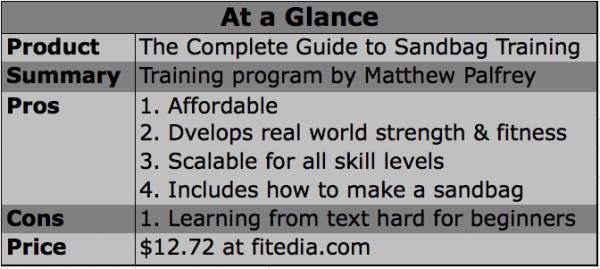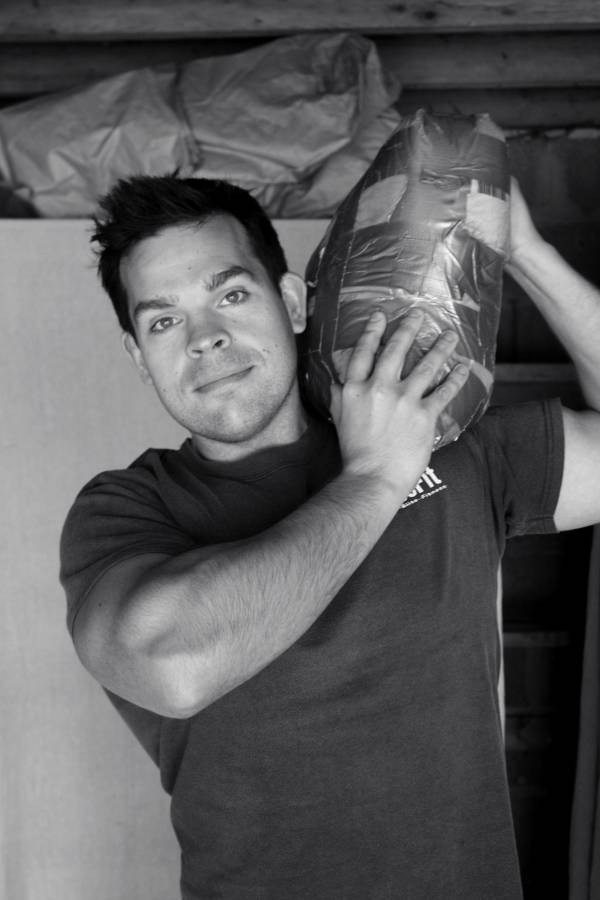
You know the slow-motion group high five that marked the end of way too many 1990s-era sitcom television shows? It’s always right before the credits and the shot usually zoomed in on the hands and they’d freeze the shot right at the climax. It’s cinematography’s expression of, “Yes!” Well, as a writer I try to suppress my biases, but as an avid follower of Matthew Palfrey’s blog, Sandbag Fitness, I felt like doing my own rendition of the slow-motion jumping high five when I caught word that I’d be receiving his e-book, The Complete Guide to Sandbag Training, to review for you all.

Matthew Palfrey has become a bit of a subject matter expert when it comes to all-things-sandbag. Maybe it’s because I am a guy and think sandbag training is cool, or maybe it’s because I own a makeshift gym (10 Essential Items To Outfit Your Home Gym) and need equipment-less options to get people fit, but my appreciation for Palfrey’s work is nothing new. Nearly as critical as the training itself is for whom this training is designed. Sandbag training is a viable solution for people without access to a gym and/or with little money who want real world strength and don’t have much time.
As a coach, I’d like to note that sandbag training isn’t just a Plan B-type option for people who don’t have access to real equipment. Odd lifts, like that of sandbags, stones, axels, or logs, bring a type of real world capacity that one could argue barbells and other standard training tools don’t provide. In that way, the very first line of The Complete Guide to Sandbag Training reads, “This thing is awkward to lift.” And, with that we have access to an inexpensive, readily available, and effective training tool.
Not only does Palfrey have a handle on movements and training programs, he gets the intangible value of sandbag training as well as anyone. He lists the following benefits to training with sandbags:
- Ability to travel
- Value for your money
- Sandbags are malleable
- Builds grip strength
Once you’ve been convinced that this is good stuff, Palfrey even provides clear instructions for building your very own sandbags for training. The e-book walks you through the process of creating both custom sandbags and homemade sandbags. Custom sandbags are essentially bags purchased from a manufacturer like Brute Force Training or Rogue Fitness specifically for fitness and they are made custom with the load and utility of their handles. Homemade bags are just as straight foreword as you can imagine. There’s a rucksack involved, some sand, and a ton of heavy-duty duct tape. Outside of the obvious need for a sandbag, Palfrey goes on to note the importance of a pull up bar, a box (for jumping), and a timing mechanism.
With the necessary tools in place, the foundation is set for some training. This sandbag training program encourages some smart training tactics, which are outlined in the book. These include logging workout results (time, load, work to rest periods), as well as some finer details like scaling, and some notes about how it felt, quality of movement, etc.
With full descriptors, images, and progressions in place, Palfrey continues to build out the training program with specific warm ups and training movements. Though I’ve expressed my love for the training application of sandbag work, Palfrey also shows great quality control with regards to his movements of choice. The program outlines and utilizes wholesome training movements as basic and important as the squat, clean, and press, for example.
The program itself is three pronged by skill level. Beginner, intermediate, and advanced athletes can enjoy their own respective training protocols that are comprised of four efforts (two strength and two metabolic) per week. The beginner program is ten weeks of training basic strength work (5×5) and conditioning sessions that include couplets and triplets of movements and running. The tenth week, then, is a challenge opportunity for athletes to record maximal efforts across a few movements and a 1K run effort.
The program is designed linearly, so as athletes complete one section they are able to advance to the next. The intermediate program starts where the beginner program left off, with added volume. Strength sessions, for example, include five movements instead of the four outlined in the beginner program. As the program builds to the advanced program, it’s important to note that not only does the intensity and volume of the training increase but so does the technique. By the time athletes reach the advanced stage, deadlifts, presses, and pull ups are often replaced with more complex movements like sandbag clean and jerks and L-pull ups, which are represented in the challenges that appear every ten weeks.
What’s an athlete to do if they diligently pass through all three programs? Does progress come to a sharp halt as they are left to their own devices? Of course Palfrey has planned for this and suggests these athletes go to his daily blog. Here they can tackle an ever-changing training protocol with the experience and mastery to get results on their own. As someone with my own similar workout-of-the-day-training type blog, I’ve got a tremendous amount of appreciation for the homework that Palfrey has done. I am confident in the structure he has put in place here, and I feel like a participant of any capacity would benefit from his program.
In the world of fitness, there’s so much passion and experience out there that there’s often no stone left unturned. When it comes to sandbag training, Palfrey isn’t necessarily an innovator, but his program fills a rare hole in the fitness world and brings quality training home to anyone who’d like to train. I’d say that The Complete Guide to Sandbag Training is probably the best blend of high performance training and low barrier to entry available.
“The Complete Guide to Sandbag Training” is available at Amazon.
You can buy the book for $6.36 with the promo code: breakingmuscle50
You can also read Matt Palfrey’s posts here on Breaking Muscle:
5 Best Dumbbell Exercises To Get Strong (And Gather a Crowd)
How to Use Sandbag Training For MMA and Combat Sports
Read our review of Matt’s first book:
“Sandbag Training for MMA & Combat Sports” by Matthew Palfrey & Wesley Murch






